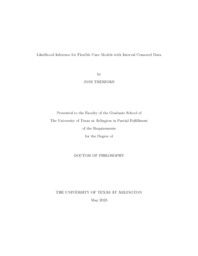
ATTENTION: The works hosted here are being migrated to a new repository that will consolidate resources, improve discoverability, and better show UTA's research impact on the global community. We will update authors as the migration progresses. Please see MavMatrix for more information.
Show simple item record
| dc.contributor.advisor | Pal, Suvra | |
| dc.creator | Treszoks, Jodi | |
| dc.date.accessioned | 2023-06-14T17:07:12Z | |
| dc.date.available | 2023-06-14T17:07:12Z | |
| dc.date.created | 2023-05 | |
| dc.date.issued | 2023-05-19 | |
| dc.date.submitted | May 2023 | |
| dc.identifier.uri | http://hdl.handle.net/10106/31268 | |
| dc.description.abstract | Models for survival data with a surviving fraction, known as cure rate models, play a vital role in survival analysis. Due to the improvement of intervening methodologies, some subjects are seen to be immune permanently. While cure rate models have been studied extensively in the recent literature with a standard assumption of right-censored data, in many applied settings, such as recidivism studies or medical studies where the event of interest is not immediately harmful, continuous observation of a subject is impracticable. We call lifetime data generated with discrete follow-up times as interval-censored.
In this thesis, we extend several existing cure models to accommodate interval censoring and develop efficient likelihood-based inference methods. We first extend two destructive cure rate models, in which a certain number of competing risks are reduced by a destructive mechanism, to the interval-censored setting. For the destructive shifted Poisson model under interval censoring, we propose an efficient expectation maximization (EM) algorithm by using the conditional distributions of the missing data to decompose the conditional expected complete log-likelihood function into simpler functions which are maximized independently and evaluate the performance of this algorithm through Monte Carlo simulation and analysis of recidivism data. Likelihood inference for the interval-censored destructive negative binomial cure rate model is developed using the conditional distributions of the missing data in two distinct implementations of the EM algorithm and a variation of the EM algorithm called the stochastic EM (SEM) algorithm. We address the advantages of the recommended estimation method, the SEM algorithm, through simulation study and analysis of smoking cessation data. Finally, we use a semi-parametric framework to extend the Box-Cox transformation cure rate model to the interval-censored setting, formulate the EM algorithm, and present a comprehensive simulation study addressing its performance and an analysis of smoking cessation data. | |
| dc.format.mimetype | application/pdf | |
| dc.language.iso | en_US | |
| dc.subject | EM algorithm | |
| dc.subject | SEM algorithm | |
| dc.subject | Interval censoring | |
| dc.subject | Cure models | |
| dc.subject | Box-Cox transformation | |
| dc.subject | Competing causes | |
| dc.subject | Profile likelihood | |
| dc.subject | Smoking cessation | |
| dc.subject | Crime recidivism | |
| dc.subject | Weibull distribution | |
| dc.title | Likelihood Inference for Flexible Cure Models with Interval Censored Data | |
| dc.type | Thesis | |
| dc.date.updated | 2023-06-14T17:07:12Z | |
| thesis.degree.department | Mathematics | |
| thesis.degree.grantor | The University of Texas at Arlington | |
| thesis.degree.level | Doctoral | |
| thesis.degree.name | Doctor of Philosophy in Mathematics | |
| dc.type.material | text | |
| dc.creator.orcid | 0000-0001-6213-1194 | |
Files in this item
- Name:
- TRESZOKS-DISSERTATION-2023.pdf
- Size:
- 1.076Mb
- Format:
- PDF
- Name:
- Dissertation.zip
- Size:
- 567.0Kb
- Format:
- Unknown
This item appears in the following Collection(s)
Show simple item record


